 |
: a musical classification |
||||||||
| From an instrumental point of view, the ceramics whistle belongs to three distinct instrumental types usually badly identified. |
|||||||||
 Drawings H. NIXDORFF Tönender Ton (Fig.4 p.19)
|
|||||||||
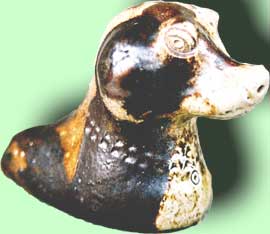 Globular whistle. One playing hole La Borne(Cher) Valentine CHAMERON. |
The globular whistle is the first type of whistle. The resonant piece is made of a closed vessel. The sound is produced directly on the edge of this vessel. Its sound has a weak intensity and generally a rather deep tone. The variation of the sound is not determined by the place of the playing holes but by the opened surface. This type is the most widespread in Western and central Europe. It is the majority in the French production of the 19th century. |
||||||||
| The second type groups together the tubular whistles . Rarely made separatly, they are generally inserted into the body or placed at the base of a zoomorphic or anthropomorphic statuette.
The tubular whistle is a flute without playing hole and with a very short pipe. Its tonality depends then on the bore and the length of this pipe. For the clay whistles, this sound is strident because they are very short whistles.
The difference between these two types (globular and tubular) is however not as distinct as it appears. Some rather long tubular whistles can be stopped at their end to modulate the sound. They work then like small globular whistles. |
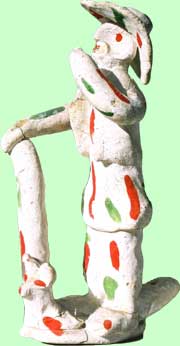 Tubular whistle inserted on the base. Siurell of the Balearic Islands 1st half 20th century |
||||||||
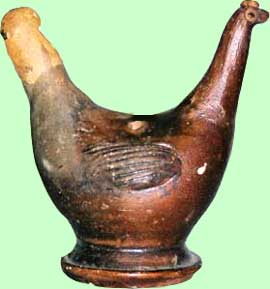 Water whistle. 2 filling holes Unknown origin. 19th C. |
The water whistles are the last type. Those whistles are made of a tubular whistle inserted in a globular vessel filled with water. The whistle works like a tubular whistle with its end closed by water but under the effect of the blast, the length of the resonant body varies as in the case of a piston. There are then trilles like the song of a bird. The filling can be carried out by a rather broad opening in top of the whistle. The whistle then has the general shape of a jug or an owl. In the case of a closed vessel (bird...), the whistle generally has one or two filling holes. The second hole makes possible an easier evacuation of the air when the whistle is plunged into water to be filled.
| ||||||||
| For a correct identification of the whistle types: . It's not always easy to identify a whistle correctly especially with the often incomplete old whistles found in the archaelogical sites.
|
|||||||||
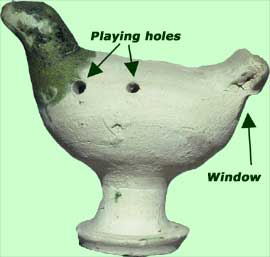 Globular whistle Prévelle (Sarthe). Ludovic BARBE. Early 20th C. |
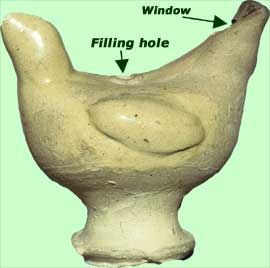 Water whistle Connéré? (Sarthe) Early 20th C. |
||||||||